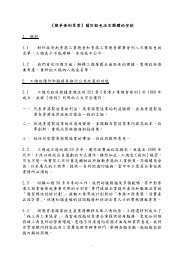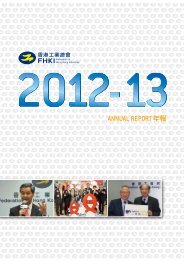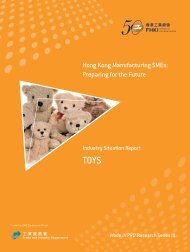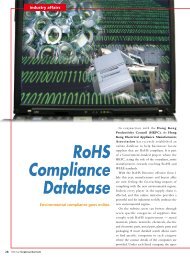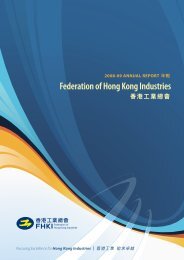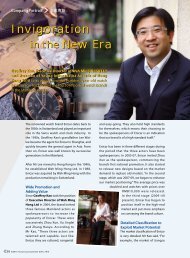Hong Kong Manufacturing SMEs: Preparing for the Future
Hong Kong Manufacturing SMEs: Preparing for the Future
Hong Kong Manufacturing SMEs: Preparing for the Future
- No tags were found...
You also want an ePaper? Increase the reach of your titles
YUMPU automatically turns print PDFs into web optimized ePapers that Google loves.
114• Who will manage <strong>the</strong> firm into <strong>the</strong> future?• When might it be necessary or beneficial to engagein collective action with respect to supplychain development, relocation, or o<strong>the</strong>r issues?It will be very difficult <strong>for</strong> <strong>Hong</strong> <strong>Kong</strong>’s manufacturing<strong>SMEs</strong> to survive and thrive if <strong>the</strong>y do not have goodanswers to <strong>the</strong>se questions. On <strong>the</strong> o<strong>the</strong>r hand,developing good answers to <strong>the</strong>se questions is <strong>the</strong>first step in facing and meeting <strong>the</strong> challenges thatconfront <strong>Hong</strong> <strong>Kong</strong>’s manufacturing <strong>SMEs</strong>.Potential <strong>for</strong> Collective ActionThe strategic options listed above focus <strong>for</strong> <strong>the</strong> mostpart on what <strong>the</strong> individual firm could or shoulddo. However, <strong>the</strong>re are some responses to strategicchallenges that may be appropriate <strong>for</strong> collectiveaction. While <strong>SMEs</strong> often find ways of collaboratingin terms of lobbying ef<strong>for</strong>ts and <strong>the</strong> general provisionof in<strong>for</strong>mation and management training, it is far lesscommon to find <strong>SMEs</strong> collaborating on operationalbusiness matters. The list below is a partial list of <strong>the</strong>sorts of collective action that <strong>SMEs</strong> may engage into overcome <strong>the</strong> disadvantages of small scale. Someof <strong>the</strong> items focus on dealing with external issues,o<strong>the</strong>rs focus on trying to obtain <strong>the</strong> benefits of scalethrough collective action. They include:• Investments in effluent control that areeffective only in large scale. Some industries,like electroplating, semiconductor production,lea<strong>the</strong>r tanning, fabric dyeing, and o<strong>the</strong>rs areby <strong>the</strong>ir nature polluting. In some cases, <strong>the</strong>reare means of handling <strong>the</strong> effluent that are onlytechnologically effective or cost-effective if <strong>the</strong>yoperate at relatively large scale. By definition,such investments or scale will be beyond <strong>the</strong>means of individual <strong>SMEs</strong>. However, <strong>SMEs</strong>banding toge<strong>the</strong>r to ei<strong>the</strong>r invest in appropriatetechnologies, or relocating to <strong>the</strong> same place to<strong>the</strong> investment can be made, may bring <strong>the</strong>setechnologies into play. In Spain, <strong>for</strong> example, agroup of lea<strong>the</strong>r producer <strong>SMEs</strong> cooperated toset up a third party firm to handle <strong>the</strong> effluentfrom <strong>the</strong> tanning process <strong>for</strong> all of <strong>the</strong>m. A groupof <strong>Hong</strong> <strong>Kong</strong> electroplating companies havebeen negotiating to relocate to a single industrialpark in Guangdong.• Relocation of production chains. Relocation dueto high costs can be difficult <strong>for</strong> individual <strong>SMEs</strong>because if <strong>the</strong>y move on <strong>the</strong>ir own <strong>the</strong>y mayseparate <strong>the</strong>mselves from <strong>the</strong>ir supply chain. On<strong>the</strong> o<strong>the</strong>r hand, if a sufficient number of firmsrelocate to <strong>the</strong> same location, <strong>the</strong>y may provideenough of a critical mass to pull <strong>the</strong> supply chainwith <strong>the</strong>m. In Nor<strong>the</strong>rn Italy, a group of footwearmanufacturers decided to all set up production in<strong>the</strong> same town in Romania. This induced enoughof <strong>the</strong> supply chain to follow to make <strong>the</strong> moveviable. A few years ago, 11 Chinese mobilephone manufacturers all moved in concert toHuizhou. They were able to negotiate with <strong>the</strong>municipal government <strong>for</strong> facilities and even<strong>the</strong> establishment of a mobile communicationsresearch centre to support <strong>the</strong>ir activities.• Bulk purchasing. <strong>SMEs</strong> often cannot purchaseinputs and materials at <strong>the</strong> same prices of largerfirms with higher volumes. This disadvantage canpotentially be overcome through coordinatedbulk purchasing. There are many examples ofthis worldwide with groups of firms coordinatingto purchase, raw materials, components,warehouse space, transportation services, marketintelligence, consulting services, accounting andpayroll services, and o<strong>the</strong>r business requirements.• Full line provision. Some customers, particularlylarge retailers or OEM customers, may desire topurchase a full line of products from a singlesource. Normally <strong>SMEs</strong> cannot hope to supplysuch customers. However, in some cases it maybe possible <strong>for</strong> <strong>SMEs</strong> to join <strong>for</strong>ces to supply <strong>the</strong>full line that <strong>the</strong> customer desires. This requiresa unified approach and clear division of labouramong <strong>the</strong> <strong>SMEs</strong>.





